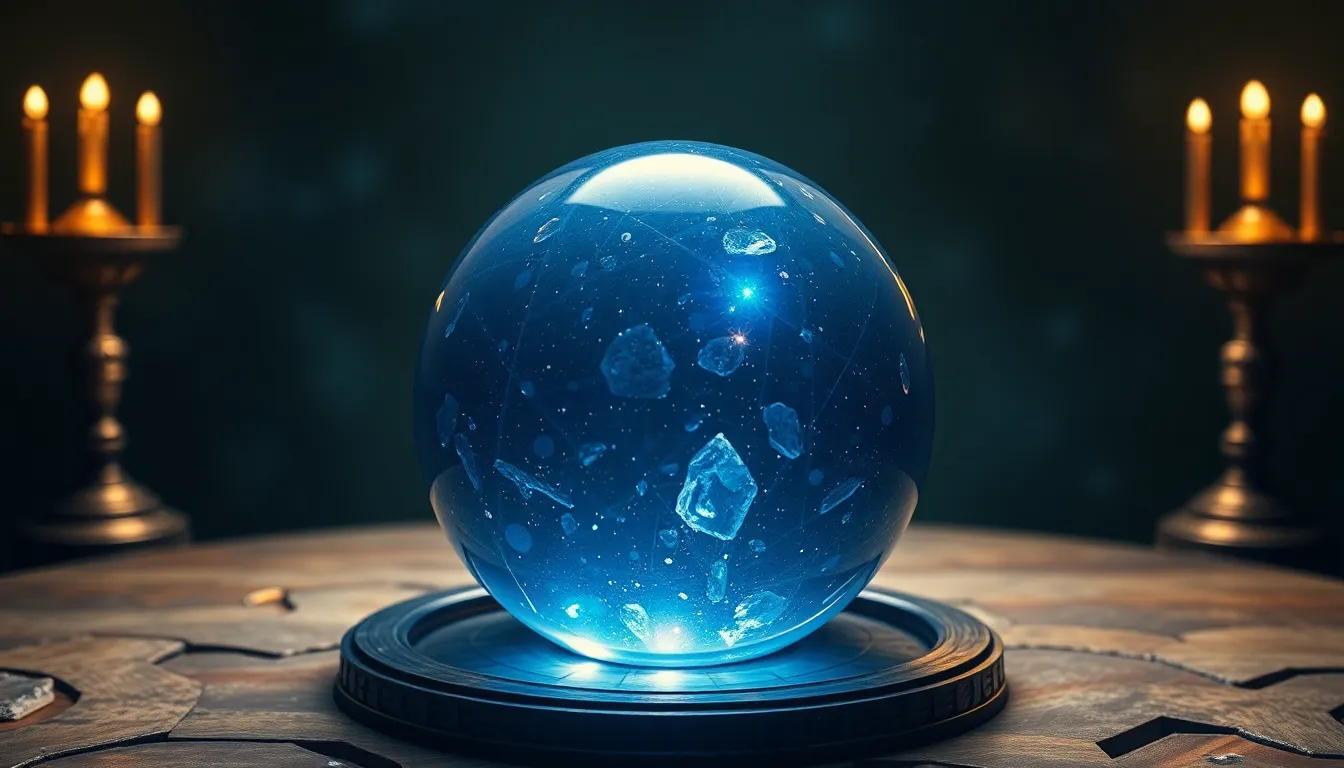The Enigma of the Crystal Ball: A Legendary Artifact of Insight
I. Introduction to the Crystal Ball
The crystal ball is a fascinating object that has captivated human imagination for centuries. Often associated with mysticism and the occult, it serves as a tool for divination and insight. In this article, we will explore its history, significance, and the various cultural interpretations surrounding this legendary artifact.
A. Definition and Historical Context
A crystal ball is typically a transparent orb made from glass or crystal, used primarily in the practice of scrying—a method of divination that involves gazing into the ball to receive visions or messages. Historically, the crystal ball has been linked to various ancient civilizations, where it was thought to hold the power to reveal hidden truths.
B. The Crystal Ball in Popular Culture
In contemporary society, the crystal ball is often depicted in movies, literature, and television as a symbol of fortune-telling and supernatural insight. It evokes images of fortune tellers draped in exotic fabrics, surrounded by candles and incense, peering into the depths of the orb for glimpses of the future.
C. Purpose of the Article
This article aims to delve into the origins, materials, cultural significance, and modern interpretations of the crystal ball, shedding light on its enduring legacy as a symbol of insight and knowledge.
II. Origins of the Crystal Ball
A. Ancient Civilizations: Scrying Practices
The practice of scrying dates back to ancient civilizations, including the Egyptians and Babylonians, who used reflective surfaces like water and polished stone for divination. The crystal ball as we know it began to take shape in Europe during the Middle Ages.
B. The Role of the Crystal Ball in Early Divination
In early divination practices, the crystal ball was believed to be a vessel for the spirits and a means to communicate with the divine. Practitioners would enter trance-like states, seeking guidance and wisdom from the otherworldly.
C. Evolution Through Time: From Antiquity to the Middle Ages
Throughout the centuries, the crystal ball evolved from a simple reflective surface to a polished sphere made from various materials. The Middle Ages saw a resurgence in interest in the occult, solidifying the crystal ball’s place in the realm of divination.
III. Materials and Craftsmanship
A. Types of Crystals Used in Crystal Balls
Crystal balls can be made from a variety of materials, with the most common being:
- Clear Quartz
- Amethyst
- Rose Quartz
- Obsidian
Each type of crystal is believed to have unique properties that can influence the reading experience.
B. The Art of Crafting a Crystal Ball
The craftsmanship involved in creating a crystal ball is an art form. Skilled artisans carefully shape and polish the crystal to achieve a flawless surface that enhances clarity and reflection. The larger the ball, the more challenging it is to create, making larger crystals rare and highly valued.
C. Cultural Variations in Crystal Ball Construction
Different cultures have their own methods of crafting crystal balls, often incorporating local materials and traditional techniques. For example, in some Eastern cultures, crystal balls are crafted with intricate engravings that hold spiritual significance.
IV. The Science Behind Scrying
A. Psychological Aspects of Scrying
Scrying is not just an act of gazing; it involves psychological processes where the mind enters a state of altered consciousness. This can lead to heightened intuition and perception, allowing practitioners to interpret symbols and visions that arise.
B. The Role of Light and Reflection
The effectiveness of a crystal ball in scrying also relies on the interaction of light and reflection. The crystal’s surface can create illusions and distortions, prompting the viewer to perceive images that may not be immediately apparent.
C. Modern Interpretations and Scientific Critiques
While many still embrace scrying as a legitimate practice, modern science often critiques it, attributing experiences to psychological phenomena rather than supernatural insight. Skeptics argue that any perceived revelations are products of the mind’s interpretation of random patterns.
V. The Crystal Ball in Different Cultures
A. European Traditions and Folklore
In European folklore, crystal balls were often associated with witches and sorcerers. They were believed to hold magical properties and were used in rituals to predict the future or seek guidance.
B. Eastern Philosophies and Practices
In Eastern cultures, particularly in Chinese traditions, crystal balls are sometimes used in feng shui practices to enhance the flow of energy (qi) in a space, promoting balance and harmony.
C. Indigenous Perspectives on Scrying Tools
Indigenous cultures around the world have their own forms of divination, often utilizing natural objects like water, stones, or crystals. The crystal ball represents a fusion of these ancient practices with more modern interpretations.
VI. Famous Crystal Balls in History
A. Notable Figures and Their Crystal Balls
Throughout history, many notable figures have been associated with crystal balls, including:
- Madame Blavatsky, a founder of the Theosophical Society
- John Dee, an advisor to Queen Elizabeth I
- Edgar Cayce, known as the “Sleeping Prophet”
B. Legends and Myths Surrounding Famous Crystal Balls
Many legends exist about famous crystal balls, often attributing them with extraordinary powers. These tales add to the mystique of the crystal ball, making it an object of fascination.
C. The Impact of These Artifacts on Society
The crystal ball has not only influenced spiritual practices but has also permeated art, literature, and popular culture, becoming a symbol of the quest for knowledge and insight.
VII. The Crystal Ball in Modern Divination Practices
A. How Contemporary Practitioners Use Crystal Balls
Today, many modern practitioners utilize crystal balls in their divination practices, often combining them with tarot cards, astrology, and other spiritual tools to enhance their readings.
B. Popular Techniques and Rituals
Common techniques for using crystal balls include:
- Setting an intention before a reading
- Creating a sacred space with candles and incense
- Entering a meditative state to enhance focus
C. The Crystal Ball in New Age Spirituality
In New Age spirituality, the crystal ball is often regarded as a tool for personal empowerment, self-reflection, and spiritual growth. It is seen as a means to connect with one’s intuition and higher self.
VIII. Symbolism and Interpretation
A. Common Symbols and Meanings in Crystal Ball Readings
During a reading, various symbols may arise, each carrying its own significance. Common symbols include:
- Water: emotions and intuition
- Fire: transformation and passion
- Animals: guidance and protection
B. The Role of Intuition in Interpretation
Interpreting what one sees in the crystal ball requires a blend of intuition and analytical thinking. Practitioners often rely on their instincts to decipher the messages conveyed through the images they perceive.
C. How Cultural Background Influences Readings
A reader’s cultural background can significantly influence their interpretation of symbols and meanings, leading to diverse insights during crystal ball readings.
IX. The Crystal Ball as a Metaphor
A.



